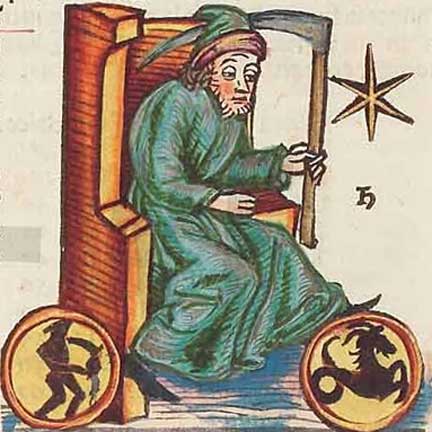Saturn in Traditional Mundane Astrology
$20.00
This special lecture for RubiCon Astrology looks at the role of Saturn in traditional mundane astrology, beginning with Abu Ma’shar’s planetary hierarchy and Saturn’s role as the king and lawgiver, then moving to Saturn-Jupiter mean conjunctions, transits of and/or to Saturn, and Saturn-Mars conjunctions in Cancer. Approx. 1 hour, with audio and slides. $20
Please use your regional Amazon location for best shipping price!
You may also like…
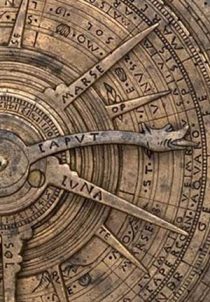
Workshop: Elements of Solar Revolutions
This 2.5-hour workshop shows in great detail how to understand and combine several traditional techniques for analyzing a native's chart from year to year, using solar revolutions (solar returns), profections, and the direction of the Ascendant of the solar revolution. Length 2:34:55, 71MB.
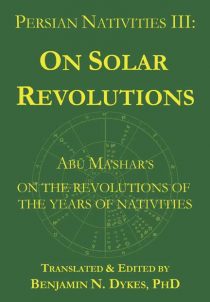
Persian Nativities III: On Solar Revolutions
This third volume of the Persian Nativities series is a translation of the surviving Latin version of Abu Ma’shar’s On the Revolutions of the Years of Nativities. It covers all of the primary predictive techniques: profections, solar revolutions, distributions, transits, and firdaria.
Related Products
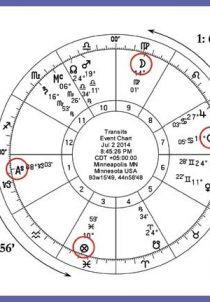
A Traditional Approach to Lots
This workshop presents rules and numerous example charts for 6 Lots (“Arabic Parts”) useful in natal interpretation: the Lots of the father, mother, children, marriage, friends, and work/action. No previous knowledge of Lots or allegiance to traditional methods is assumed. See longer description below. Contains: MP3 and slides. Length: 2:50:00, 78MB.

Introduction to Traditional Mundane Part 2
This audio lecture download discusses numerous techniques in traditional mundane, including eclipses, Saturn-Jupiter conjunctions, triplicity shifts, mundane profections, and Aries ingresses (see full description below). The download includes: MP3 audio, a handout, and slides.Length: 1:55:00, 54MB.
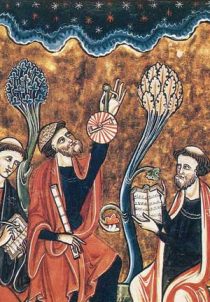
Thought-interpretation, or The Search of the Heart
This lecture describes “thought interpretation” or the practice of finding what is in a client’s “heart,” in traditional astrology. (Length: 1:00:00, 28MB.)
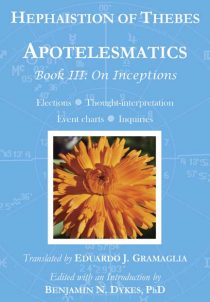
Apotelesmatics Book III: On Inceptions
Hephaistion of Thebes’ Apotelesmatics (5th Century AD) is an important record of ancient doctrines on general principles, natal, and electional astrology, largely drawn from the work of Ptolemy and Dorotheus.
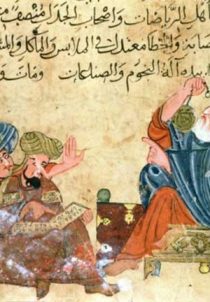
FAA 2010 Lecture: Introduction to Solar Revolutions
This short lecture introduces several solar revolution techniques, part of the Persian suite of annual predictive techniques: profections, the solar revolution chart, and transits. Length 1:08:57, 31MB.
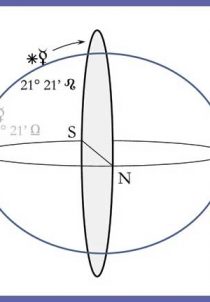
Primary Directions Without Tears
This audio download discusses how primary directions differ from other techniques like progressions, and completely explains how to calculate traditional directions using your astrology program’s animation function, illustrated with several chart example. Contains: MP3 and slides. Length: 1:45:00, 49MB.
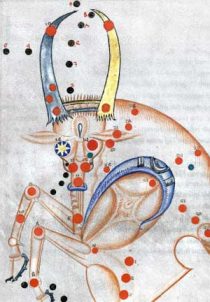
Introduction to Traditional Astrology
This lecture covers eight major differences in technique, attitude, and approach which distinguish traditional astrology from modern types. (Length 38:20, 18MB).

Introduction to Traditional Mundane Part 1
This presentation introduces traditional mundane astrology, beginning with Ptolemy’s method for interpreting and timing eclipses, prices and weather, and historical astrology: framing history into larger and smaller periods, especially using Saturn-Jupiter conjunctions. Length 1:16:09, 36MB.
